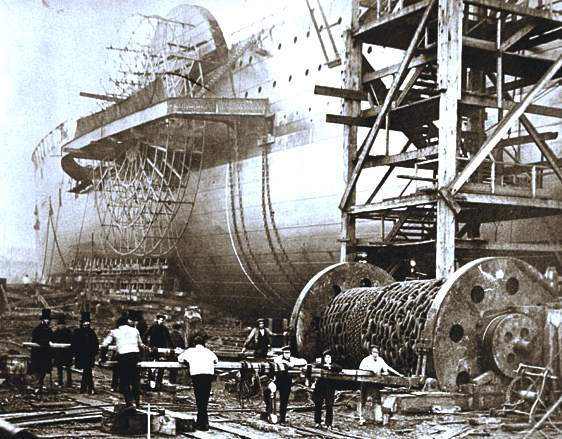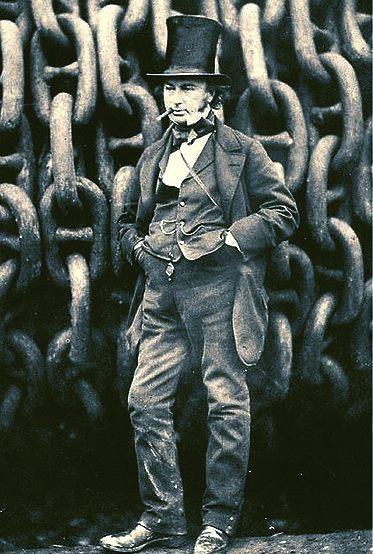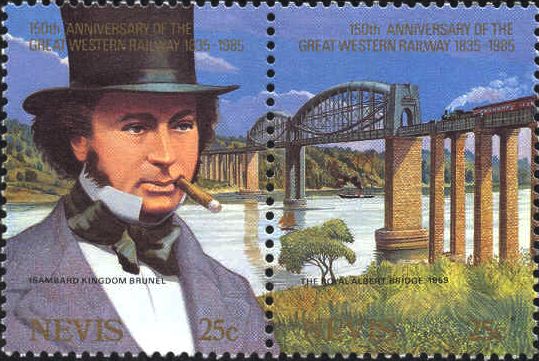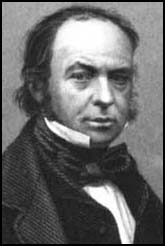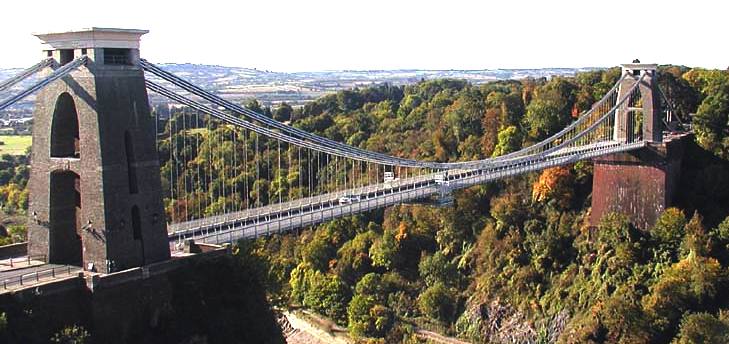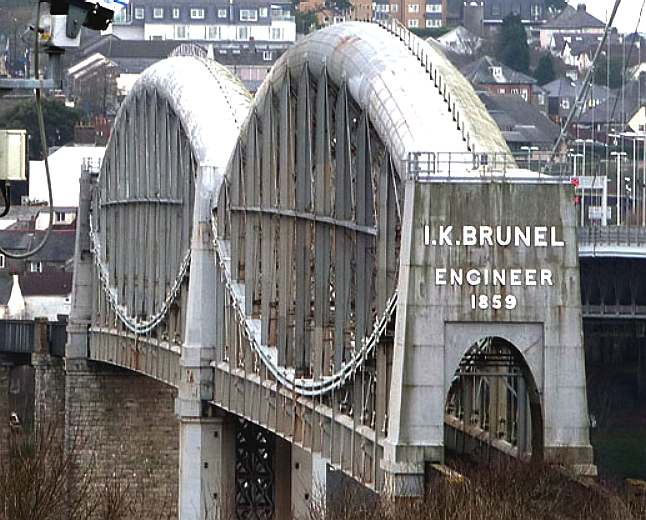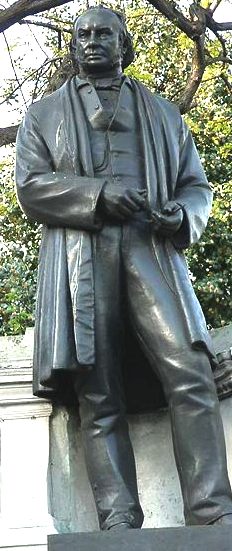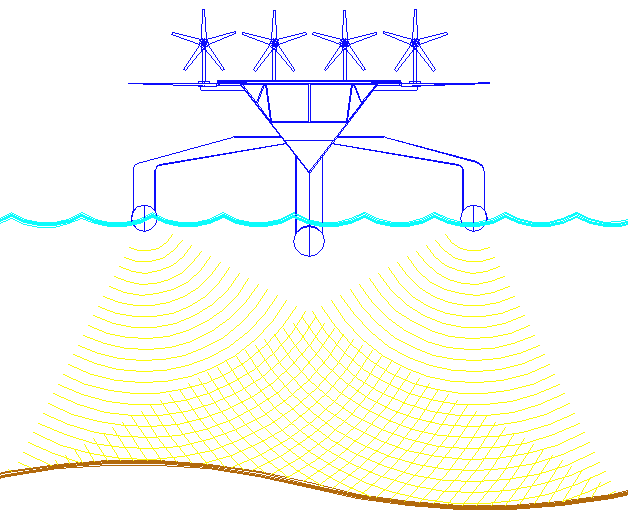|
ISAMBARD KINGDOM BRUNEL 1806-1859
|
|||
|
Isambard was born in Portsmouth on the 9th April 1806. He was the only son of a famous French engineer Sir Marc Brunel. Sir Marc was determined to see his son follow in is footsteps. He was educated at Hove, near Brighton and studied for two years at the Collège Henri Quatre, Paris, after which, in 1823, he rejoined his father in England.
Kingdom's first notable achievement was the part he played with his father in planning the Thames Tunnel from Rotherhithe to Wapping, completed in 1843. It was in 1823 Brunel went to work with his father on this project - he was just 20. He was later to be appointed as resident engineer at the site. After his work on the Thames Tunnel, Isambard planned the Clifton Suspension Bridge, over the River Avon, which was completed posthumously in 1864 using chains from his own Hungerford Suspension Bridge.
Isambard Kingdom Brunel, stamp and photo portrait
In 1829 Brunel designed a suspension bridge to cross the River Avon at Clifton. His original design was rejected on the advice of Thomas Telford. After considerable scandal, a second competition was held and one of Brunel's designs (improved) was selected, though lack of money delayed construction until after Brunel's death.
Brunel was injured seriously when the tunnel was flooded. While he was recuperating from his injuries, Brunel entered a design competition for a new bridge over the Avon Gorge. The judge of the competition was the Scottish engineer Thomas Telford. Telford rejected all designs in favour of his own.
After
being appointed chief engineer at the Bristol
Docks in 1831, Brunel designed the Monkwearmouth
Docks. He later went on to design and build similar
docks at Plymouth, Cardiff,
Brentford and Milford Haven.
Controversially, Brunel used the broad gauge (2.2 m) instead of the standard gauge (1.55m) on the line. This created problems as passengers had to transfer trains at places such as Gloucester where the two gauges met. While working on the line from Swindon to Gloucester and South Wales he devised the combination of tubular, suspension and truss bridge to cross the Wye at Chepstow. This design was further improved in his famous bridge over the Tamar at Saltash near Plymouth.
Brunel then carried out a number of dock designs at Bristol, Brentford, Milford Haven, and Plymouth. He became intrigued by the new field of railway engineering, and in 1833 he became chief engineer to the Great Western Railway.
His most remarkable feat for the GWR was the Box Tunnel, between Bath and Chippenham. This amazing tunnel was 2 miles in length, and took almost 6 years to complete. When the crews funneling from each end finally met in the middle, they were found to be a mere 1 1/4 inches out of alignment.
Brunel oversaw every aspect of railway design, from the track itself to the track layout, bridges, tunnels, rolling stock, even the lamp posts for the railway stations! He was not above rolling up his sleeves and joining his workmen in their digging.
Brunel followed his new passion for railways around the globe, designing lines in Italy, Australia, and India. He was responsible for over 1,000 miles of track in Britain. He was famous for his railway bridge design, and his Maidenhead Bridge had the flattest brick arch in the world. He also pioneered the use of compressed air to sink pier foundations underwater.
Railways did not take all of Brunel's attention; he was responsible for great advances in marine engineering as well. His Great Western paddle-wheeler (1837) was the first steamship to provide regular transatlantic service.
The Great Britain (1843) was the first major ship to use a screw-propeller, and Great Eastern (1858) was the first iron double-hulled ship, and was responsible for laying the first successful telegraph cable across the Atlantic. Each of the three ships was the largest in the world at the time of its construction.
Brunel also designed artillery and hospitals for the Crimean War effort, as well as an ingenious armored barge. Isambard Brunel was a short, neat man, who stood just over 5 feet tall. He seems to have been self-conscious about his height, and he favoured tall top hats to make himself appear taller. He was a workaholic, often laboring 18 hour days and sleeping at his office in Duke Street.
The
work for which he is probably best remembered is his
construction of a network of tunnels, bridges and
viaducts for the Great Western Railway. In March 1833,
he was appointed their chief engineer and his work began
with the line that linked London to Bristol. Impressive
achievements during its construction included the
viaducts at Hanwell and Chippenham, the Maidenhead
Bridge, the Box Tunnel and the Bristol Temple Meads
Station.
WEB RESOURCES:
More British Biography | History | Isambard Kingdom Brunel Alumni
| Brunel Family Tree
| History
of Brunel | Isambard Kingdom Brunel
Brunel's huge propellor-driven ship, THE GREAT BRITAIN is now a museum at the same Bristol dock it was built.
INVENTORS A - Z
The ultimate Robot Boat. Solarnavigator uses an advanced SWASSH hull as the platform to mount the world's first autonomous circumnavigation. A successful expedition could pave the way for improved safety at sea.
|
|||
|
This website is copyright © 1991- 2014 Electrick Publications. All rights reserved. The bird logo and names Solar Navigator and Blueplanet Ecostar are trademarks ™. The Blueplanet vehicle configuration is registered ®. All other trademarks hereby acknowledged and please note that this project should not be confused with the Australian: 'World Solar Challenge'™which is a superb road vehicle endurance race from Darwin to Adelaide. Max Energy Limited is an educational charity working hard to promote world peace.
|
|||
|
AUTOMOTIVE | BLUEPLANET | ELECTRIC CARS | ELECTRIC CYCLES | SOLAR CARS | SOLARNAVIGATOR |
